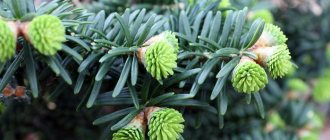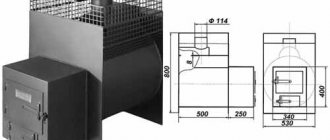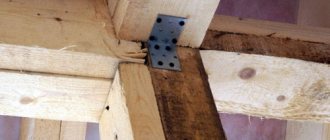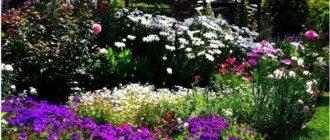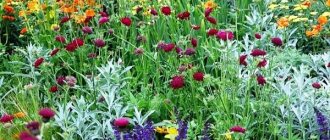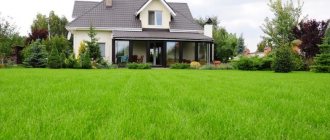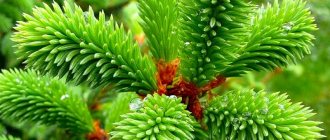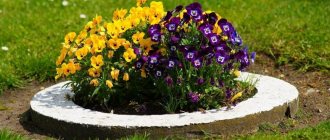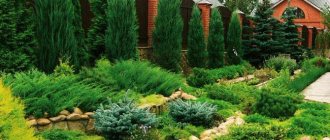A lawn under trees requires different care than a lawn grown in full sun. This is well known to those who did not pay attention to this when arranging the clearing and after a few seasons ended up with random bald spots or extensive patches of moss on it. If you are just planning to lay out a lawn, you should use a special grass mixture designed for shady areas. Here are some helpful tips for caring for your shaded grass.
Fescue varieties
Common grasses such as Kentucky bluegrass and perennial ryegrass do not like shade. They do well in full to moderate sun, and often refuse to grow in unsuitable conditions. The best grasses to sow in shade are from the Oat family. Standard varietal seed mixtures typically contain about 1/3 fescue, and among the three varieties, the dominant species will emerge depending on the amount of sunlight received. For heavily shaded areas, individual selection of varieties will likely be required to create seeding material.
Red fescue is best, but is often combined with other oat varieties to better adapt to different light loss levels and soil types. Tall fescue also does well in the shade and is often found in seed mixtures intended for such lawns.
Each variety of fescue contains many different varieties that are resistant to disease and prolonged drought, and also have good adaptability to soil substrates. They add cost and are mainly used in creating complex greens such as golf courses.
A mid-priced variety should be suitable for most shaded lawns. Cheaper seeds may result in lower germination rates and customer disappointment.
The role of endophytes
Fescue is one of the rare turf grasses that can absorb endophytes, a type of fungus that lives in symbiosis with the plant.
Endophytes do not damage the grass : in fact, their presence is beneficial to the health of the lawn. Their presence allows herbs to better withstand stress such as heat and drought, and also provides resistance to insects and rodents. Grass seed can also be inoculated with fungal spores after harvest, which is a safe and natural way to provide another level of protection against diseases, pests and other plant stresses. After this, they should be stored in a cool and dry environment, otherwise the benefits of endophytes will be significantly reduced. That’s why it’s so important to order fresh seed from a reliable manufacturer.
Warm season
The best grass for planting in the shade in the warm season is St. John's wort of low-growing varieties. But it cannot be sown with seeds directly into the ground, but should be grown with seedlings, sections of rhizomes, or planted as turf, in whole layers. Zoysia grass is also a shade-tolerant grass intended for southern climates, however, the further north the area where the lawn is located, the worse the plants will develop under the trees.
Under a shady tree
If you are trying to grow grass in your garden, you should remember that not only will the plants be deprived of sun, but they will also have to compete directly with the trees for water and nutrients.
Make sure there is suitable soil for the grass to grow near the tree trunks. She will likely need additional watering and fertilizing. It would also be beneficial if the tree canopy was thinned out a bit by pruning, this would allow more sunlight to penetrate to the base.
Sometimes grass refuses to grow in a shaded area because it is not designed for it. It may be necessary to come up with non-standard solutions for such areas, for example, mulching the area or planting other plants, such as pachysandra. They can be limited to a circle around the trunk, or left alone and allowed to grow naturally.
Let's start with a simple question: why isn't ordinary grass suitable?
At first glance, there is nothing complicated here, you just need to let ordinary grass grow and you will get a gorgeous lawn, no strange grass mixtures are needed. However, this is far from true; the answer is somewhat more complicated.
To create a good lawn, using common weed grass as a candidate is not the smartest choice. At a minimum, because the weed is interspersed with other weeds. Moreover, this grass is very hard and broad-leaved, unlike specially cultivated grasses for lawns, the leaves of which are soft, tender, and also grow densely, preventing bald spots and weeds from entering.
Perhaps these arguments will be enough for you to choose a high-quality grass mixture as a lawn at your summer cottage. Plus, you already know in advance what your lawn will be like. Moreover, a high-quality grass mixture will save you from weeds, weeds and allergenic plants.
Special grass mixtures
Even before the start of excavation work, the owner of the territory where the lawn will be created needs to determine the degree of shading in the selected part of the garden (permanent or partial). This is very important, since individual plant species have varying degrees of tolerance to both light and shade. Therefore, it is worth choosing the right mixture of grasses at the very beginning, before arranging the lawn.
For places with high and constant shading, the most suitable will be fescue and other species that grow quickly and quickly cover the surface without bald spots. However, they have different humidity requirements. Low-growing fescue, growing in the shade, develops well in dry places, and panicles of tall varieties prefer wetter areas. Turf varieties work very well in the shade, but their seeds are much more expensive than other plants. Ready-made mixtures, selected according to the degree of shade and humidity, can be purchased at garden centers. For less shady areas, compositions of filamentous fescue and meadow broom are best suited.
Laurentia river
Laurentia or isotoma is a herbaceous plant up to 30 centimeters high. It is highly valued in landscape design because of its pleasant form of dense bushes and delicate, star-like flowers.
River laurentia blooms all summer, and in favorable weather conditions - until October, and prefers moist soils and shaded places. It grows poorly in very waterlogged soil and the roots may begin to rot. Tolerates frosts well down to -10 degrees.
Unwanted moss
This is a problem in shaded areas of the lawn, especially if the soil is too dense, impervious or acidic and poor in nutrients. Annual early spring scarification will help remove mosses, but it is much more important to properly fertilize the root layer. After checking, if the soil pH is acidic, it is also a good idea to sprinkle the soil with lime and sand. It is recommended to use magnesium lime, which is commercially available in granules, which simplifies its use. If necessary, this procedure is carried out annually until the quality of the lawn is completely improved and islands of moss are removed.
Additionally, the lawn is fed with a special fertilizer containing iron sulfate, which acts as an inhibitor on moss. A few weeks after applying the fertilizer, the fluffy growths begin to turn brown and die. After this, it needs to be raked and taken outside the site. Large patches of bare soil in the lawn are seeded with a suitable grass mixture.
To improve a lawn growing in the shade:
- Step 1 - Selectively trim thin tree branches to allow better sunlight penetration and improved air circulation. This should be done once or twice a year as the crown shoots grow.
- Step 2 - it is recommended to mow shaded lawn grasses to a height of 5-6 cm, but it is better to leave it higher, up to 10 cm.
- Step 3 – Water your lawn only as needed to avoid creating prolonged drought conditions. Deep irrigation once or twice a month is preferable to shallow and frequent watering.
- Step 4 - Herbaceous plants in the shade develop slowly and are quite pale in color. Therefore, they require less nitrogen than a lawn in full sun. In most cases, it is necessary to apply 500 g of nitrogen to a clearing measuring 10 m². Fertilization should be carried out in October or November; this will be enough to provide normal nutrition to the roots throughout the year. It should also be remembered that in the absence of sunlight, shade-loving broad-leaved weeds, such as wild violet or ground ivy, thrive. Under such conditions, plant diseases (powdery mildew, late blight, brown spot) often break out. To control them, special drugs are used. For these products to be effective, you must follow the instructions on the package.
Lawn arrangement - two options: sowing and roll
There are two ways to create a beautiful lawn: sow with a mixture of seeds or unroll a ready-made lawn from a roll. What's better? Each has its own advantages and disadvantages.
It is best to plant a seed lawn at the turn of August/September or April/May. Then the temperature stabilizes, the substrate is optimally moistened and the danger of drought usually disappears. You can make a lawn at another time, but the effect may be worse. To keep it healthy, you need to choose a composition of varieties that matches the conditions of a particular garden. In addition to the typical mixtures of ornamental (carpet) and recreational (universal) grasses, shady or trampling-resistant flower meadows are on sale, as well as restorative mixtures for repairing damaged lawns. A lawn of 100 m² requires 2.5–3 kg of seeds. They should germinate in 10-16 days, depending on the species and prevailing weather, but turf takes several months to mature.
It is recommended to lay a roll lawn from April to November because it is more resistant to frost than newly germinating grass. The garden owner simply needs to keep the substrate moist. An undeniable advantage is that immediately after unfolding you get a dense green lawn. This variety is most often prepared for household or decorative lawns. If turf is needed, it is ordered approximately two months in advance. Grass in rolls is also suitable for slopes with a significant slope. Before purchasing, you should check the quality of the lawn. The flap (usually 50x200 cm), raised at one end, should not fall apart. You also need to inspect its roots. They should be light, without dry tops. Once delivered, lawn rollers cannot wait, ideally they should be rolled out within a day or two, otherwise the edges will begin to dry out and the finished lawn will not live up to the customer's expectations. This variety requires the same care as a seeded lawn. Opponents of the rolled version argue that areas of “felt” appear on its surface quite quickly, so they require more intensive care.
Horned frog
This perennial plant is known for its spectacular appearance, as well as healing properties, and is used in folk medicine. The height reaches about half a meter, the flowers are bright, yellow, with a beautiful orange border.
Recent Entries
Lilac perennials that are beautiful, compact and do not crowd out other plants Why when buying seedlings you should not take the sellers’ word for it and how to determine the age of the plant using 3 signs Tomato seedlings have turned purple or whitish: why the color has changed and how to save the plants
This flower is considered one of the hardiest: it grows well on poor loamy soil, is resistant to drought and flooding, and can grow in windy and cold climates. Suitable for those who want to get a beautiful flowering meadow on their site without spending time and effort.
Lawn care
Regularly mowed lawns require fertilizer. Good results are achieved by fertilizing with compost, which provides quickly absorbed nutrients, improves soil structure, protects it from moisture loss and stimulates the activity of soil microorganisms. It is enough to sprinkle the granules on the surface twice a season in a layer of 1-2 cm. At the beginning of April, and then again in July or August, you can use multi-component fertilizers, preferably specialized ones. To prepare your lawn for winter, it is worth feeding it with autumn fertilizers with a small amount of nitrogen and a high content of potassium and phosphorus. Dolomite or chalk can be applied every three to six years to reduce the acidity of the soil and facilitate the absorption of other elements.
If a layer of “felt” (compacted shoots and rhizomes) appears on the lawn, it is necessary to carry out scarification. For this, a special tool with sharp knives is used, cutting the turf and soil to a depth of 3-7 cm. If it is not available on the farm, the same operation is performed with ordinary garden forks, piercing the soil every 20-30 cm.
The lawn is cut twice, the second time perpendicular to the first, after which the plant debris is very carefully raked. If you do not remove the “felt”, its layer becomes thicker and thicker, young tufts of grass accumulate on it, since they do not have the opportunity to take root in the ground, and the surface becomes lumpy.
Watering is a procedure that cannot be neglected. It is best to do this less often, but intensively, in the early morning or late afternoon with a stream broken into fragments. Water should seep in gradually, preferably to a depth of 15 cm.
The first spring mowing is carried out when the grass is 8-10 cm high. Later, mow when the grass grows 4-6 cm, and shorten it by 1/3 of its entire height.
In autumn it is worth aerating the substrate. This way its structure will be weakened and oxygen will be given access to the root layer. Aerators are equipped with spikes or pointed tubes. It is good to fill the resulting holes with sand, as it facilitates breathing and growth of the root system of vegetation.
Duchesnea indica
Ground cover perennial grass with creeping shoots. The plant takes root easily and blooms throughout the entire summer season. The leaf blades are trifoliate, dark green in color, and shaped like strawberry ones. Bright small berries are a real decoration for a green carpet.
Duchesnea grows very quickly and prefers sunny areas. Feels good on depleted soils. In fertile soil, the plant practically does not bloom, but the leaves grow and develop more abundantly.
It can be sown all season - spring and summer. In winter, it requires shelter if there is no snow.
Ground cover plants instead of lawn
For shade, other solutions can be used, namely: instead of lawn grass, under large trees, place plants that are suitable for such an environment and do not need frequent care. Or, instead of fighting the moss, which is its natural habitat, why not let it grow? A soft, mossy rug is sure to be a very pleasant place to relax on hot summer days.
You can plant shade-loving perennials that effectively cover the shaded area. Ivy is best suited for this, as it is evergreen and grows very quickly. Perennials will take root well: common periwinkle, Japanese swampweed, Virginia, and common Dubrovnik.
Although shade trees are an important and prominent feature in many landscapes, they will compete with the lawn, causing problems that lead to disease and death of the turf. They will also always have competition for light, water and nutrients. In addition, air flow under trees is usually limited, which increases humidity and increases disease rates. In response, the density of the turf planting decreases as it becomes more succulent and develops elongated leaves and shallow roots. These factors make it difficult to maintain dense, healthy grass in the shade.
Turf performs best in minimal sunlight, ranging from four to six hours a day. Before attempting to maintain grass cover under trees, it is important to evaluate the need for turf in that particular area. Better choices may be to use shade-tolerant groundcover perennials, rock beds, mulch or pebbles instead of turfgrass. This option may be easier to maintain and more aesthetically attractive. If the area is expected to be subject to heavy traffic, you should consider installing pavers, gravel, or a layer of shredded tree bark.
Although many lawn plants thrive in full sun rather than shade, some types of grass thrive in the shade. Owners of poorly lit areas should consider using shade-loving herbal mixtures: tall fescue 100%; 50% fine fescue and 50% Kentucky bluegrass, a combination of 50% fine fescue, 30% Kentucky bluegrass and 20% perennial ryegrass. It is inexpensive and requires minimal ground cover maintenance. These are low or creeping herbaceous perennials, the main function of which is to create a uniform plant cover. They are characterized by strong growth, resistance to diseases, pests and damage, they are durable, long-lived, and frost-resistant.
After planting at a suitable distance, a full-fledged plant carpet will grow in one or two growing seasons, because the growth vigor of such mixtures is higher than that of weeds. An additional benefit is their flowering. The leaves can also be colorful and attractive. Evergreen species are often recommended, with the added benefit of providing winter foliage.
As a rule, ground cover plants are absolutely undemanding. But when choosing suitable species, you should pay attention to their need for light. Among plants of this type there is a large group of species that tolerate shade well. They can be a valuable addition to shaded garden spaces and, if chosen correctly, will create an interesting composition in areas considered unsuitable for plants.
In theory, groundcover perennials can be planted all year round (except winter). September is the most recommended date for successful planting of perennials (division and propagation by rhizomes). Spring will also be a favorable time for this work.
Shade tolerance is a characteristic that applies to any type of grass or combination of its varieties. It can range from partial shade (some sun during the day) to full shade (no light for most of the day), or it can be referred to as dappled shade (tolerates a location under light tree branches). Some grasses adapt better to varying degrees of low light.
Rock garden
A rock garden can be a great alternative to a lawn. However, in this case, it is better to plant more flowers and shrubs between the stones; you can arrange beautiful compositions in flowerpots. By the way, we have already written about which plants are best to grow in pots in your garden, be sure to read this article!
Photo from the site https://yandex.ua
How to replace lawn grass in the shade
Many plants can be called groundcovers by observing how quickly and strongly they grow throughout the garden, densely covering the available space. They can be planted instead of lawn grasses in very problematic places.
Plants for shade:
- Common ivy (Hedera helix) makes a great filler around tree trunks where grass growth is usually difficult to maintain. It quickly covers the free spaces with a network of deciduous shoots. A valuable species for shaded areas of the forest.
- Periwinkle (Vinca minor) is a low soil requirement plant in our forests. Its tiny dark green leaves form dense carpets that are covered in a field of purple flowers in spring.
- The evergreen and very attractive creeping tenacious (Ajuga reptans) is a forest perennial of the middle zone. Typically, the leaves remain throughout the winter and turn dark burgundy in early spring. The plant quickly grows with shoots, overtakes weeds and soon fills the bed. It makes an excellent backdrop for many shrubs, is easy to plant and can be the leading understory of a shade garden.
- Fortune's euonymus (Euonymus fortunei) is an excellent ground cover shrub. There are quite well-known varieties with yellow leaves (Emerald'n Gold) and white-variegated ones (Emerald'n Gaiety), the Coloratus variety is especially noteworthy. It has larger leaves, stiff and dark green, which turn dark red in the fall and remain that way throughout the winter.
- Japanese pachysandra (Pachysandra terminalis) is an evergreen shrub with small white flowers that appear in May, but the flowers are not the plant's main feature. In a fairly short time, on moist soil, bright green shiny leaves form soft carpets that densely cover the soil.
A smooth emerald lawn is an important part of the garden. A smooth lawn provides an excellent backdrop for surrounding plants, enhances the beauty of the architecture and is an excellent place to relax.
Weed species
When used correctly, wild plants will help maintain the decorative appearance of a non-standard sports lawn. The grass recovers quickly and is not demanding in terms of care. It is important to choose beautiful views with original texture.
Bird's knotweed
An annual plant with a recumbent, branched stem, it can be used as a lawn alternative. The crop quickly covers the soil, forming a soft, pleasant carpet. Knotweed is resistant to trampling and is easily restored after cutting.
Knotweed for lawns Source sovdok.ru
The culture needs bright sun to develop. Knotweed is undemanding when it comes to soil nutrition, but grows well with periodic fertilization. Grass can be sown both on a flat lawn and on a problematic landscape.
